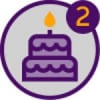Does your LO do this?


When my mom is in bed she often puts her feet on the floor and then her head comes off the bed and almost touches the floor. The only part on the bed in her bottom and she has fallen ot of bed. She does the same thing on the couch if she falls asleep there.
We've tried a bed rail and a bumper, but then she is unable to get out of bed. She is able to go to the bathroom by herself.
Comments
-
One of the PTs that came out here had a patient that would do that (at a facility) and since they couldn’t use rails and such, they ended up putting a thick pad on the floor next to them.0
-
We tried that and she can't use her walker on the cushion and fell everytime when she went to go to the bathroom at night.
I just think it is a no win situation.
If she is completely on the bed she can get up by herself. It is when she is asleep and starts to slide off that she goes on to the floor. She does it about once a week.
We tried a small rail, but then she can't figure out how to get into and out of bed. She gets up anywhere from 2-10 times a night.
She has been independent in going to the bathroom at night.
0 -
Sorry to hear about your situation. Was the bed rail you tried a Partial Bed Rail (ie, only about 2 ft long)?My LO has really benefited from her partial bed rail. I’ve put it right at the head of the bed, so it runs along her head and shoulder. She is able to get in and out of bed easily by gripping it. It has 4 horizontal bars, and a cover, so it’s not possible for her to get hands or head caught in it.
https://www.rehabmart.com/product/half-length-hospital-bed-rail-31860.html
My apologies if you’ve already tried a partial bed rail, and experimented with where to place it on bed!
Another product I’ve used is a bed alarm, which sends an alarm to a transmitter in my bedroom when my LO gets up. The alarm does not go off in LO’s bedroom, which is great. The alarm works with a pad placed on the mattress, and it can be challenging to determine the best placement on the bed, whether to put under or over mattress cover, etc, but it has been useful.
https://www.alimed.com/replacement-patient-alarm-transmitter-unit.html
0 -
How is her mobility? Would she be able to get up off of her mattress if you put it on the floor? Or would the bed be low enough if you removed the box spring?
We recently eliminated my mom's box spring because she hangs her legs off of the bed and I was afraid she'd roll out in her sleep. Her bed is quite low now, so her feet touch the floor and give her a bit of stability, and even if she does roll out she's unlikely to get hurt.
She gets up in the night to use a commode so we couldn't use a bed rail or soft materials on the floor either.
0 -
Her bed doesn't have a box spring. It is just a mattress and frame. I can't put it on the floor since she would not be able to get up by herself.
We do have a small rail closer to her head which helps with her head not coming off the bed. If we put the bar any further down she thinks she is stuck in bed and can't figure out how to get into or out of bed.
We tried the mat that buzzes when her feet hit it. She sets it off everytime her leg go off the bed and it was going off multiple times per night when she was still asleep but her feet were on it.
I just don't think there is an answer.
0
Commonly Used Abbreviations
DH = Dear Husband
DW= Dear Wife, Darling Wife
LO = Loved One
ES = Early Stage
EO = Early Onset
FTD = Frontotemporal Dementia
VD = Vascular Dementia
MC = Memory Care
AL = Assisted Living
POA = Power of Attorney
Read more
Categories
- All Categories
- 532 Living With Alzheimer's or Dementia
- 271 I Am Living With Alzheimer's or Other Dementia
- 261 I Am Living With Younger Onset Alzheimer's
- 15.8K Supporting Someone Living with Dementia
- 5.5K I Am a Caregiver (General Topics)
- 7.6K Caring For a Spouse or Partner
- 2.4K Caring for a Parent
- 203 Caring Long Distance
- 124 Supporting Those Who Have Lost Someone
- 16 Discusiones en Español
- 5 Vivir con Alzheimer u Otra Demencia
- 4 Vivo con Alzheimer u Otra Demencia
- 1 Vivo con Alzheimer de Inicio Más Joven
- 11 Prestación de Cuidado
- 2 Soy Cuidador (Temas Generales)
- 8 Cuidar de un Padre
- 22 ALZConnected Resources
- View Discussions For People Living with Dementia
- View Discussions for Caregivers
- Discusiones en Español
- Browse All Discussions
- Dementia Resources
- 6 Account Assistance
- 16 Help



